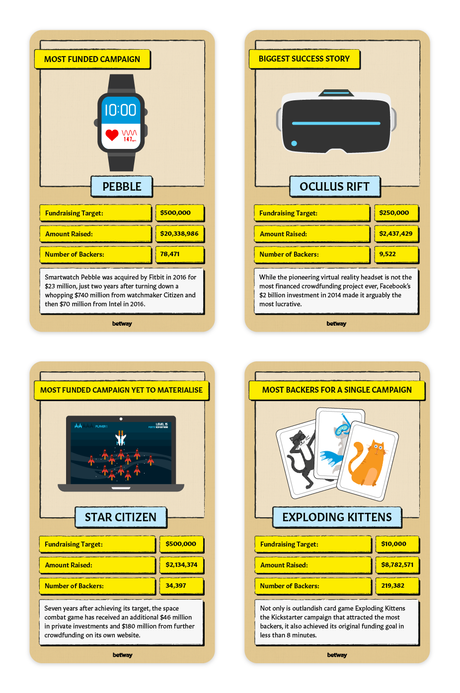
To celebrate Kickstarter’s 10th anniversary, we decided to talk about the four of the best practices of gaining investment from the general public, while also taking into consideration what did not work.
Due to the lack of funding, starting their own company or even just create a product seemed quite impossible for most people until 2009. In April of that year, Kickstarter revolutionised the world of financing by directly implicating the end users: the customers.
Although crowdfunding was not something new, Kickstarter took this concept and made it mainstream. It made possible that many entrepreneurs, inventors, and even artist had their ideas turned into reality. How? People started pre-ordering products. This led to a quick financing of the product, and the end users also received various rewards according to the amount of money pledged.
Crowdfunding is similar to an online casino, because companies sometimes gamble by relying only on crowdfunding. However, only 36% of these projects actually reach the targeted amount. The main risk for the customers lies in the fact that even though a project exceeds their target, the product might never be delivered. However, this hasn’t stopped people from pledging more than $4.2 billion into various Kickstarter projects in the last few years.
We chose four examples that we found to be representative of campaigns that were successful in one way or another.

The Greatest Success Story: Oculus Rift
Without any doubt, one of the most successful product launched though Kickstarter was Oculus Rift, a virtual reality (VR) advancement that had a great impact on technology. This headset had the ability to transport users into a hyperrealistic 3D dimension with high quality images.
Although some corporations were interested in the product, the company lacked the necessary financial support to develop the technology. However, by exhibiting the VR headset at various conventions, the founder, Palmer Luckey managed to catch the attention of big names from the tech industry.
The mass media started to promote this revolutionary VR device, and after only four hours since the launch of a Kickstarter campaign, the project reached its $250.000 target on August 1st 2012. After a month of the Kickstarter campaign, the Oculus Rift project added more than $2.4m in funds, which represented almost 1000% of the targeted amount.
Even though it might not be the most financed crowdfunding project (Facebook managed to top it two years later), it is one of the most lucrative.
With the help of the funding, the first generation of the product was available to the public in 2016. The release confirmed the impact of Kickstarter and the faith of the investors.
Campaign with the Highest Funding: Pebble Time
Pebble had tremendous results when it managed to raise $10,266,845 in 2012, exceeding the initial target of the smartwatch of $100,000 by 10,167%. In 2015, the target amount was exceeded yet again. In just 17 minutes, the funding goal had been achieved, meanwhile in only 49 minutes it jumped to $1 million, being the most funded Kickstarter campaign ever.
Even though Pebble impressed with its high-resolution screens and graphics, while providing simple watches with e-ink screens (display popular among E-Readers), which resulted in long-lasting battery life, it still did not manage to attract customers that were loyal to Android Wear and Apple Watch.
The company turned down $740 million from Citizen in 2015, $70 million from Intel in 2016, finally being acquired by Fitbit for the small amount of $23 million in 2016. Even though the technology was used for creating Fitbit products, the majority of the Pebble employees along with the chief executive were laid off. Pebble products were phased out, leading to their discontinuity in 2018.
Most Funded Campaign Not Yet Materialised: Star Citizen
If you happen to be one of the 2.3 people who decided to pledge money for the development of Citizen, Cloud Imperium Games’ “epic space adventure”, you might have just lost your patience. The initial Kickstarter campaign was launched in 2012 and the game managed to attract $2.1million from more than 34.000 funders, which was an amount four times higher than the initial goal. In the next seven years, $46 million had been privately invested, and approximately $180 million were raised though another crowdfunding campaign, this one on the webpage of the game. The only problem was that the game ceased to appear. The deadline keeps being delayed, while the money keeps expanding the game’s scope.
There were some small parts of the game that have been released to the backers, along with promises of rewards in the game for their contributions, and especially their patience. The company had made it harder and harder for people to get refunds for their crowdfunding initiative, so that disappointed backers could not reclaim their money.
Highest Number of Backers: Exploding Kittens
After Card Against Humanity’s $15.6k score in 2011, another card game made the news when it reached the highest number of backers on Kickstarter. Exploding Kittens, a highly entertaining card game, which was launched in 2015, managed to reach its funding goal of $10,000 in just one day. Over 219.000 backers raised almost $8.8 million.
This campaign managed to succeed not only because of its fun concept, but also because of the creative approach that the funders had towards the crowdfunding process. Instead of asking for money, like in the case of most campaigns, the funders decided to engage the community, making Kickstarter a game itself.
Funny tasks like posting pictures of ten people with cat ears would bring the backers extra rewards such as a limited edition box that meowed when it was opened. Backers were also encouraged to be involved in the creation of the product by coming up with ideas to improve the card game.
This unique way of approaching crowdfunding proved to be a great lesson for other campaigns as well, by moving the focus from the funding to the funders.
Some of the data from this article was taken from The Insider.
